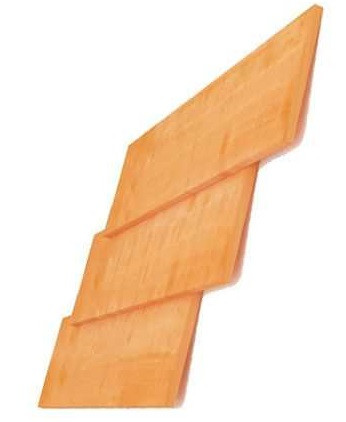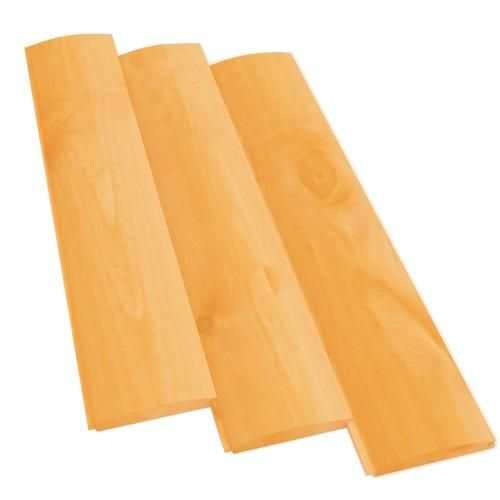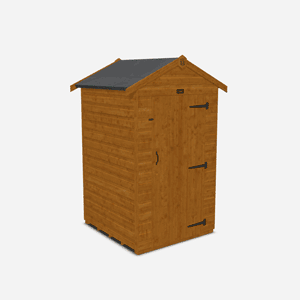What’s the Right Shed Cladding for Your Needs?
Published: 20/08/2021

Whether you’re thinking about building your shed from scratch, or you want to buy the best shed for your needs, you should know about shed cladding.
The importance of cladding for your shed
Cladding not only influences the style and look of your shed – it also plays an important role in a garden building’s ability to keep out the rain, wind, and damp. You might not know what shed cladding is and you’ve come here to find out. Or perhaps you’d just like to understand the differences between types of cladding, so you can make an informed decision when buying a new shed or building your own. In this post, we aim to answer any questions you may have on timber cladding for sheds. So, let’s get started…
What is shed cladding?

The term cladding refers to the material that covers a shed. Types of shed cladding include the following:
- Tongue and groove
- Shiplap*
- Overlap
- Loglap
- Waney edge**
- Featheredge
- Rebated featheredge***
- PMV
* A form of tongue and groove cladding ** A form of overlap cladding *** Widely said to be a form of featheredge cladding When people talk about cladding, they’re usually referring to the joint – the way in which the cladding boards or panels join together. As each type of cladding has its own distinctive look, the term also refers to the style of a shed. You may have read or heard people talk about cladding in reference to the type of wood e.g. cedar cladding. However, this is somewhat misleading because it’s not related to the type of joint or style. That said, the type of timber contributes significantly to the strength and quality of any shed cladding. And this is why we talk about timber later in this post. So what can you use to clad a shed (or what should you use)? Let's take a closer look...
Different types of shed cladding in the UK
In the last section, we listed different types of shed cladding. In this section, we go through each type in the list and describe what makes it unique. Note: Throughout this post, we refer to timber rather than plastic shed cladding. Here are 8 types of shed cladding:
1. Tongue and groove (also known as T&G)

As we state in our article on tongue and groove cladding for sheds, a tongue and groove cladding board features one or two grooves (or slots) at one end, and one or two tongues (protruding pieces of wood) at the other end (see above). The tongue of one board fits into the groove of another identical board – and this process is repeated until several boards form a panel. There are several advantages to tongue and groove cladding. These include the following:
- Strength – tongue and groove boards boast a tight fit that increases resistance to wind and rain
- Security – this added strength means they’re also more secure
- Appearance – the seamless join between every between each board creates a sleeker look
But shiplap cladding is even better. Here’s why…
2. Shiplap

An upgraded form of tongue and groove, shiplap cladding features an extra channel that allows water to run off quickly, instead of collecting between the tongue and the groove. Shiplap boards also feature smooth planed timber which further aids water run-off. All sheds in the Tiger range feature 12mm thick shiplap cladding. That’s all except our Elite range of pressure-treated sheds, which feature 16mm shiplap.
3. Overlap

Sheds made with overlap cladding use sawn timber boards. Each board overlaps – and is attached securely to – the board beneath. While this design often prevents rainwater from getting inside, overlap cladding is not as tight and is therefore less resistant to leaks. Even so, the best overlap sheds use the finest timber and offer great value for money.
4. Waney edge

Waney-edge boards are often by-products from the process of cutting beams. And as its name suggests, waney-edge cladding features waney edges (edges that have peaks and troughs and aren’t straight). These edges are sliced straight from the tree and still have the bark on them. This creates a rustic look that can add real character to your shed. These boards also tend to be quite thick – usually between 19mm and 25mm, which gives great potential for insulating a shed. That said, waney-edge cladding is a form of overlap, with each board overlapping the one beneath – which creates wider gaps between each board than shiplap. This, in turn, makes this form of shed cladding more susceptible to wind and rain. And when we said that waney-edge boards are sliced straight from the tree, we weren’t kidding! Waney-edge cladding is often quite green (it hasn’t been seasoned). In other words, it hasn’t had time to become free of moisture – any seasoning that occurs does so while on the shed.
Why is the lack of seasoning a potential issue?
Seasoning allows timber to absorb or drive out moisture to create an equilibrium with its environment [1]. By contrast, unseasoned wood can swell or shrink. This poses a risk to the structure of a shed, which could warp and sag as a result.
5. Loglap

Also known as log lap and logboard, loglap is a form of tongue and groove cladding which features boards with curved outer faces that mimic the look of real logs (as found on log cabins) – but use much less timber. At Tiger, we offer loglap cladding as an upgrade on our shiplap sheds.
6. Featheredge

Often used on cheaper sheds, featheredge (also known as feather edge) shed cladding boards are usually very thin – sometimes as small as 4mm thick. It is also known as weatherboard. Each board is sawn with a diagonal cut to produce a tapered profile. When fitted each board overlaps the one beneath. Due to its small size, feather edge shed cladding tends to warp. As a result, we don’t recommend sheds with this form of cladding.
7. Rebated featheredge
Also known as rebated planed face tapered cladding, this form of cladding has a similar look to standard featheredge. In fact, we’ve heard rebated featheredge cladding described as both ‘similar to’ and as ‘a form of’ feather edge shed cladding.
So, how is rebated featheredge cladding different to standard featheredge?
As its alternative name suggests, rebated featheredge boards are planed on both sides – meaning they have a smoother face than the ‘normal’ form of featheredge cladding. The bottom back end of each board also features a groove, which is machined to ensure the back lines up with the board below it.
8. PMV (Planed Machined V-Joint)
In the UK, readymade PMV sheds are rare – possibly due to the more complex profile. If you search PMV shed cladding online, you’re likely to find cladding boards with this type of joint, but not whole sheds. As a result, it’s fair to say PMV cladding is more for people who wish to build their shed from scratch.
So, what is PMV?
PMV is similar to tongue and groove cladding in a way – both have tongues and grooves. But the first difference is that the bits of wood either side of the groove are cut at different lengths; the bottom of the longer side is also cut at an angle (see above). The helps to drain away rainwater more easily than if it were cut at 90°.
What is the best timber for garden shed cladding?
As we say on this page, the type of timber you use for shed cladding is even more important than the profile. This is because it affects everything from the appearance to the strength and lifespan of your shed (and summerhouses and log cabins too!)
The importance of using sustainable timber

Wood is the world’s only renewable resource – trees cover more than 33% of Plant Earth. That said, forests are disappearing at an alarming rate – which could potentially have dire consequences. Why? Because trees are essential for the environment, the well-being of our children and the planet as a whole. This is because trees play a vital role in producing oxygen and absorbing carbon dioxide. With this in mind, it’s important to find timber from sustainable sources. At Tiger, every one of our garden buildings is sustainably sourced.
The benefits of European softwood
You may have seen references to European softwood throughout our website. This is because we believe it’s the best. To be specific, Tiger uses the following types of timber for any shed:
- Scandinavian timber (5ths or above)
To be even more specific, examples of Scandinavian timber include pine and spruce – also known as European redwood and European whitewood. These types of timber are slow-grown, which makes them denser and therefore stronger – due to the closer grain.
High-grade timber (good enough for specialist furniture makers)
These timbers are commonly found on specialist handmade furniture. By contrast, many of our UK competitors source their timber from other Baltic regions, where factories have a reputation for harvesting timber too quickly. That may also be why many of our competitors offer a 10-year guarantee, whereas Tiger offers a market-leading 20-year guarantee on its garden buildings.
What is the cheapest shed cladding?
We hear this question a lot. To answer it, overlap or featheredge are the cheapest shed cladding types. That said, they are certainly not the best. Featheredge cladding tends to be very thin (as thin as 4mm). And while the best overlap shed cladding tends to be thicker (around 9mm) and provides great value for money.
The best shed cladding
If you're looking for an inexpensive shed, we recommend one with overlap cladding (as opposed to low-grade featheredge). If this is the option you want to go for, make sure you choose an overlap building made of high-quality timber. But overall, the best cladding for a shed has to be shiplap – especially if you’re buying a readymade shed. This is because it provides the perfect blend of quality and ease of construction.
For the highest-quality overlap and shiplap cladding for sheds, go to Tigersheds.com.
Reference
[1] https://bioresources.cnr.ncsu.edu/resources/calculating-the-equilibrium-moisture-content-for-wood-based-on-humidity-measurements/






